Michał Borowik, a 27-year-old from Warsaw, has been building up his collection of contemporary art— the Borowik Collection— since 2005. According to the U.S. Modern Painters Magazine and Artinfo.com, it is one of the fifty most important collections of contemporary art in the world. His name has been placed next to Dasha Zhukova, founder of Moscow’s Garage Centre for Contemporary Culture and partner of Roman Abramovich. The Borowik Collection is also mentioned among the 173 world’s most significant collections of contemporary art from 34 countries, just next to the Rubell Family, Saatchi Gallery or Zabludowicz Collection.
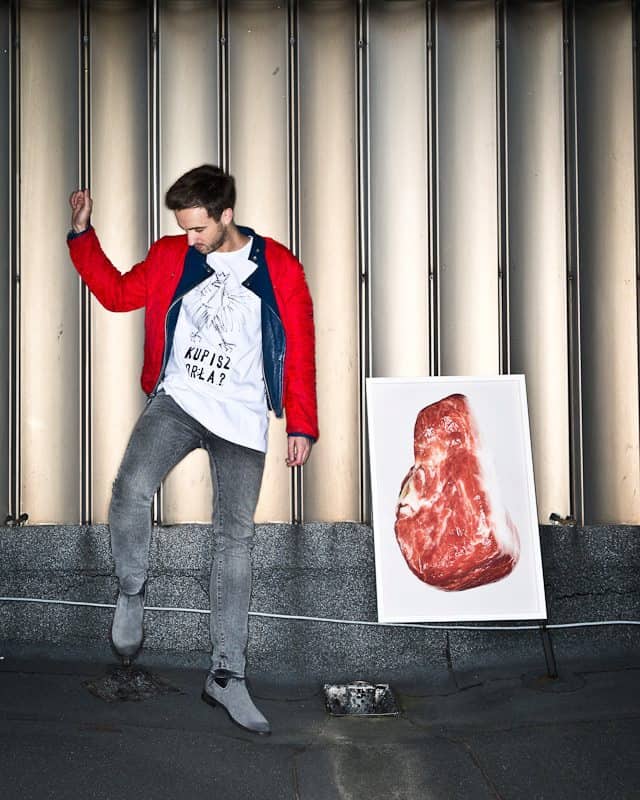
Michał Borowik has been creating his own collection of contemporary art entitled “the Borowik Collection.” According to the U.S magazine “Modern Painters Magazine” and website Artinfo.com, his collection belongs to the fifty most important collections of contemporary art in the world. Photo Rafał Masłow for Zwierciadło magazine, courtesy Borowik Collection
German carmaker BMW in its BMW Art Guide, published by Hatje Cantz and Independent Collectors, yet again found the Borowik Collection to be one of the most interesting in Poland. The other gallery mentioned in the guide belongs to the Polish wealthiest women, Grażyna Kulczyk. A group of art critics and curators praised the Borowik Collection for its timeless character and personal message. “I’m trying to prove that Poland’s most recent art is valuable and needs attention,” Michał Borowik told Rzeczpospolita.
Contemporary Lynx: Michał, you are all over the place: on television, giving radio and press interviews, writing articles about Polish art world for Sukces magazine. Your name and your collection are on everybody’s lips. Tell us, is it difficult for a twenty-something- year-old person to become an art collector?
Michał Borowik: I am far from being a careerist. Eight years ago, I did not expect that the collection would attract any interest at all. I am exploiting this moment to the limits of my physical abilities. It is a real privilege for me to show others that anyone can collect and that collecting is sexy. Art is one of the directions on my compass. There is north, south, east, and art. I sleep on art.
You do not become an artist overnight and similarly, it takes some time and maturity to become a collector. Actually, this process is still going on. It is a matter of addiction. You cannot hide it – the art is addictive and T-shirts with the inscription “Buy art, not cocaine” tell the honest truth. If you are fascinated with art, but consciously give up the AFA (Academy of Fine Arts) and painting, because you realize that what you are doing is not exactly what you were looking for, then you face a classic gap between your desires and possibilities of their implementation, which causes severe alienation. You go through all the symptoms of withdrawal and art craving – you are missing turpentine and art matter, you realize that you need some sort of expression. At one point, it came to me that collecting, exploring the field of art, and picking out pieces from all this enormity of existing art is a form of creation, too; that it can leave a mark or stamp undeniably yours. The collection is me, I am the collection -I fully identify with it.
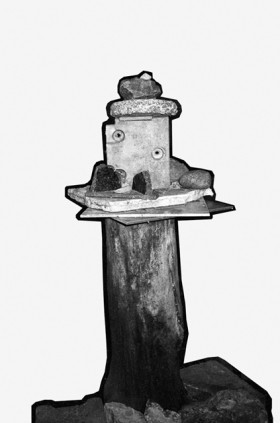
Paweł Eibel, Untitled, totem 1, inkjet print on archival paper, collage, 40 x 26 cm, courtesy Borowik Collection
CL: What does your collection contain?
MB: My collection focuses on young, emerging Polish art – it is a matter of personal sensibility and taste, not a program. It is primarily a scene on which the performance of the full colour present, bold forms, shapes and fleeting moments takes place.
The artists are often still unknown. I found most of them when they were students, or fresh graduates. Young artists are innocent. When I buy their works, I experience their self-esteem and identity being created and reinforced. It is not just about purchasing the artworks. It is about getting involved with someone’s life and where it is heading. This is a mutual and quite intense relationship. Unlike other industries, where buyers are anonymous and replaceable, here the artist’s reputation is either enhanced or tarnished by those who own his/her work. For example, in case of Michał Gayer from Katowice, I bought his diploma work and got a Warsaw gallery interested in it. It did come off and the artist had an exhibition at the Centre for Contemporary Art at Ujazdowski Castle in Warsaw. It is wonderful to see the development of the artist that you somewhere, somehow discovered. Valuable things are born in silence, so I reach to the “hidden” artists working in quietness, away from the media. I also purchase at charity or online auctions.
For me, the most important thing is not only possessing the art pieces, but making them public and helping artists out. My collection is a kind of platform or stage on which young, not yet widely known artists may come out. Its publicizing has a dual purpose – to promote the artists and to educate the public. Art should be accessible to everyone, even if not as exclusive property. The very existence of my collection, acquired thanks to the passion rather than billions of Swiss francs, only confirms this thesis.
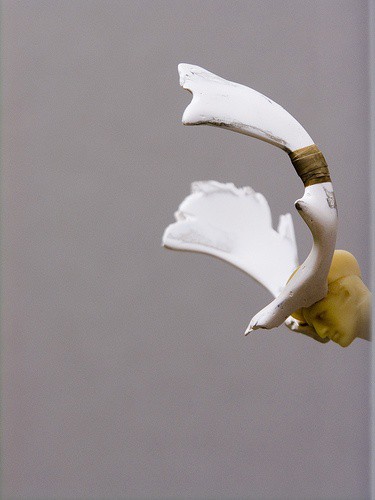
Michał Gayer, Corners of the Warsaw Uprising , 2009, mixed media, 15 x 20 cm, photo courtesy Borowik Collection
CL: What are your strategies for collecting? There are collectors who focus on the work of artists within a given generation or trend, regularly buying the works over the years. The others concentrate rather on a particular medium e.g. photography. What does it look like in your case?
MB: Twenty-five years ago, most of collections were national. In this day and age, it is hard to find a recognized collection that would showcase only the works by the artists-compatriots. This would mean it is provincial and limited. My collection is based on very subjective and personal criteria. It is like a social chronicle, a box full of souvenirs, my personal journey through Poland in search of interesting art, my memories of meetings with artists, talks and exhibitions. In our littered, multimedia culture a significant collection is not only being compiled, it is being created.
Among all the works, there is a common thread that I have been spinning for many years. All moments important in my life, both dramatic and joyful, are there. This collection is more than the sum of all parts. It is something special. It is a quest for coherence between the work and the artists. The next step is to open up to the work of foreign artists, e.g. from Romania.
CL: Your attitude toward the collection is very personal and intimate. What is the main idea behind it?
MB: The idea behind the Borowik Collection is to sensitize the public and show that “it can be different, better, not so simple or banal”. Educating and presenting various areas of Polish cultural activities is equally important. We “have” Katowice, Wroclaw, Poznan … interesting young artists are everywhere.
CL: What are your selection criteria?
MB: My selection criteria are very intimate. Choosing specific works is a way of recording my emotions, materialized someone else’s hands. The ability to add new elements to the collection-puzzle is just as important as skillful subtracting. I get rid of those works that start to annoy me, no longer fit into the emerging whole; the ones that in time become redundant, semantically exhausted and empty.
I do not have a long-term goal but I am constantly refining my collection and hope it will stand the test of time.
The most important criterion for selecting an art work for the collection is not only its medium but also the high standard of its form and execution as well as its contents. I really dislike empty shells – aesthetically satisfying works without any message. The artworks I prefer combine aesthetics with a message. Another thing I consider when choosing a piece of art is whether the medium used by the artist is the best vehicle for the message and vice versa.
I believe that the message or meaning of an art work should not have only one, abstract layer. In order to establish a meaningful relationship with its viewer it is essential, in my opinion, for the art work to trigger in him/her a whole chain of personal, intimate associations. And in order to do that an art work should be invested with some sort of a message or a story.
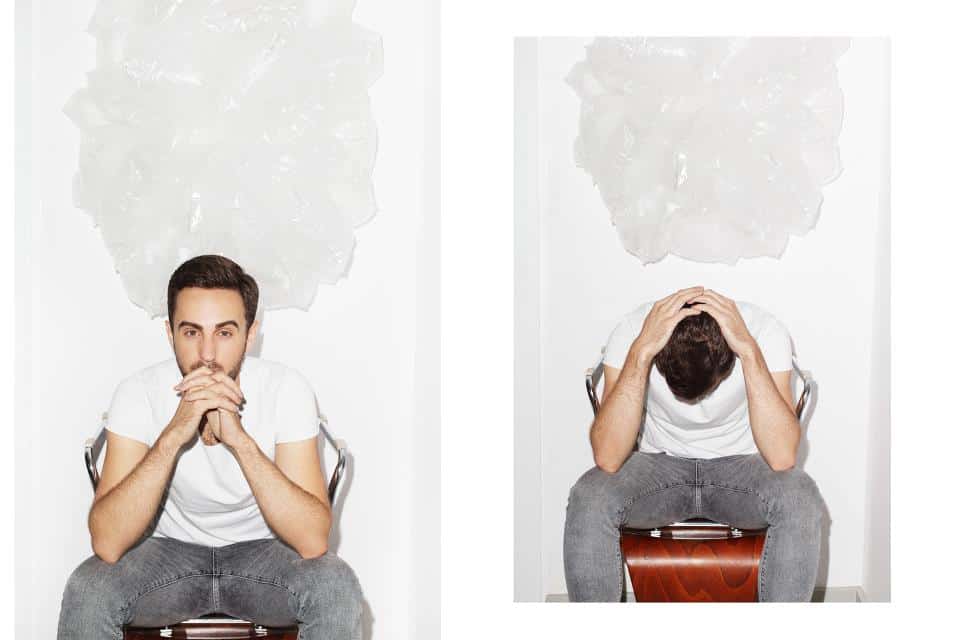
Michał Borowik, on the pictures:
Adam Gruba, piece from “Golem”. Pracownia Samowystarczalna, 2012 at Fundacja PSW Promocji Sztuki Współczesnej / Galeria Program / www.fpsw.org, Warsaw, photo Łukasz Ziętek for VIVA MODA, courtesy Borowik Collection
CL: Quite recently (June 10), the exhibition of works from your collection entitled “Borowik Collection. Dream Of” ended up at the Gallery BWA in your hometown Zamość. It is quite risky to organize an exhibition so far from Warsaw, but the viewers did show up in large numbers. Share your impressions of it, please.
MB: As for the exhibition … it was brilliant… this literal return to my roots, my homeland, the beginnings of my collecting. At the opening, more than 100 guests from Poland and abroad appeared. It turned out to be a great success! The space was perfect for what I had wanted to show. Additionally, the natural atmosphere created by Aleksandra Hirszfeld’s audio work, doubled the effect and let it naturally blend into the urban surroundings (the windows were wide open and the sound was wafting around the entire Old Town Square in Zamość). During the exhibition dates, more than 2,000 viewers visited the place, numerous lectures were conducted, and even some classes for kids from kindergarten were organized.

Dream Of // Borowik Collection, a group exhibition at the BWA Gallery in Zamosc, 10.05 – 2.06.2013, curator Michal Fopp, general view on a display, photo courtesy Borowik Collection
CL: Thanks to the exhibition in Zamość, young artists had a chance to show their works to a wider audience. What role does promoting young unknown artists play in your collector’s activities?
MB: In collecting, the most important thing is pleasure and enjoyment. To paraphrase: “the aim of the collection would be achieved if a knowledgeable viewer did enjoy it.” Then, helping and supporting the artists. We are at a time when galleries are waiving their promoting role, and the burden of these activities is imposed on artists, institutions … and collectors.
The collectors’ power lies in that they risk the most, at least financially. A purchase gesture is a gesture of promotion, it only for that reason. Today, the presence of economy in the art world is maybe not stronger than before, but definitely much more explicit and visible. Neo-Expressionism became fashionable and purchased in spite of the critics’ opinion and even now, there is no theory supporting it, apart from the strong predilection of the consumers … The huge popularity of great works by Aleksandra Waliszewska perfectly illustrates this.
My collection exists in a virtual form, as a web page accessible to everyone, where you can see different artworks and find information about the artists. When preparing the exhibition in Zamość, the challenge was, among others, to render this virtual structure into the physical space of the gallery.
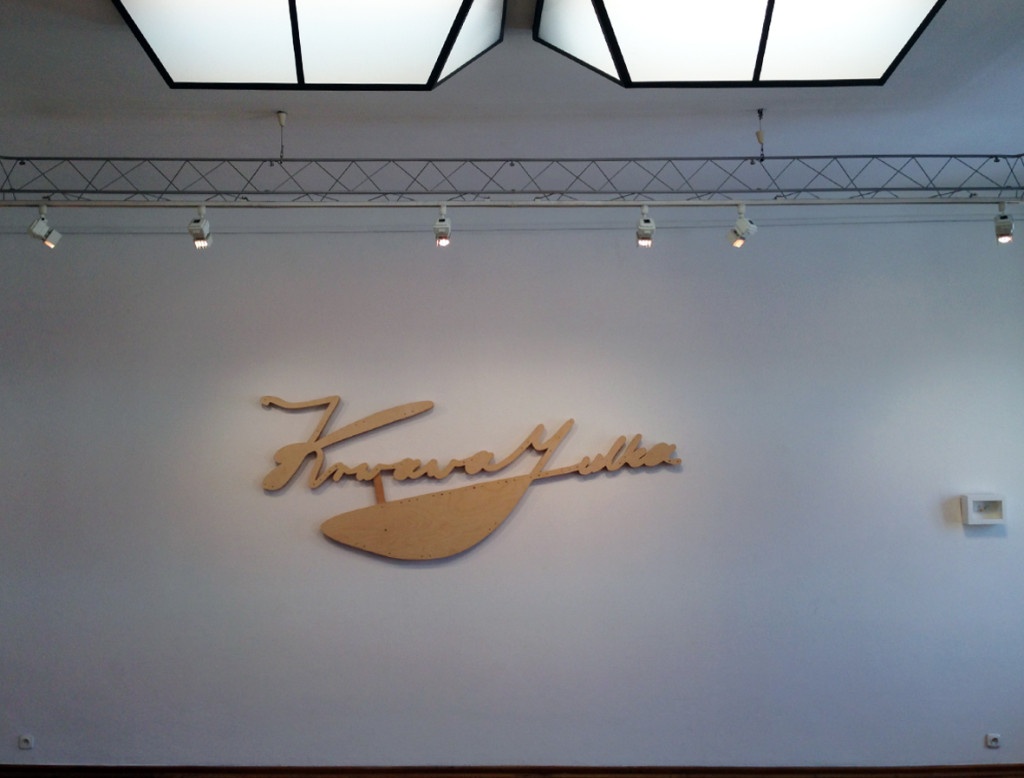
Michał Gayer, Krwawa Julka, Broken Neon 2009 (100 x 250 wood) at the BWA Gallery in Zamość, Dream Of // Borowik Collection, a group exhibition at the BWA Gallery in Zamosc, 10.05 – 2.06.2013, curator Michal Fopp, view on a display photo courtesy Borowik Collection
CL: And looking at it from the other side, that is, from the side of the promotion of collecting in Poland. Have you managed to inspire young people to buy contemporary art?
MB: Idealists are always sexier than realistic cynics – they want something, fight for something instead of sitting on the couch and complaining.
Collecting becomes sexy because of young people. As consumers, they are very picky and conscious, having been shaped by the capitalism and its specialized niches. This is a generation of hunters, who know that they want something uncommon and unique, something authentic in its uniqueness. Of all the cultural production, only the works of art meet these requirements.
Our whole generation used to collect photo stories from the chewing gums, then colourful notebook sheets, stickers (vlepki), die-cast cars (resoraki). Now, these people make their first conscious collections. Our culture provides us with the endless scope for exploration and it is really a gold-bearing area. We have been prepared for this by the other areas of the market – the golden age of young designers and fashion designers is a sign of the same transformation.
CL: For example, do novice collectors come to you asking for tips on how to start collecting?
MB: A lot of people from all over the world come to me; some are just curious curators or journalists, but there are also artists who send me their portfolios. I must say though, I have never bought any work in this way. Foreign gallery owners and collectors ask me about the Polish art scene, because all they know are, at best, the Raster, the Foksal Gallery Foundation and some artists related to them. I talk about the newer and more recent events, which is also a general form of promotion of the Polish contemporary art.
Collecting is a creative process- buying art is not so easy if you do not have that kind of financial backing as Dr. Osman Djajadisastra. Then, every decision is very significant and must be extremely well thought out. Duchamp pointed out that the interpretation, circulation of works and promotion of the artists are all parts of the creation, and that the process of the creative, artistic input cannot be separated from the whole machinery of the art market, part of which is a collector.
In my case, it’s different. It is based on renunciations, on the very concrete decisions I have made in my life. Also in this sense, I neither want nor can have “everything”.
A person that knows very little about the Polish contemporary art, and has some money to invest, should rather buy bonds. Art is not an investment unless you are very lucky and can beat the professionals at their own game. Instead, we should buy something we like. It will please us for years, and this pleasure is unquestionably worth the money. It is also worth taking some time to search for something that is really special. After all, “hunting” is half the fun.
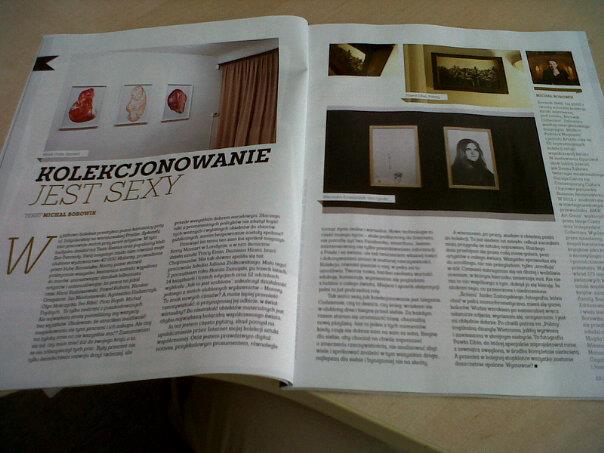
Sukces Magazine, opened on column “Collecting Is Sexy” written by Michał Borowik, courtesy Borowik Collection
CL: What are your plans for the nearest future? What places are you going to frequent? What are you going to buy? What artists are you going to “keep an eye on”?
Winter Salon (Salon Zimowy) is a laid-back Young Art fair, first held in 2011. This season, over a dozen galleries from all over Poland (although dominated by those from Warsaw), some independent publishers and music labels will take part in it. The Salon differs from the conventional art fairs in that it is not focused on the big collectors, and its prices are oriented at the so-called ordinary viewers of art. Last year, I did some great shopping there.
I do follow the Cheap Art Fair (last time it was held in Katowice), where the art somehow keeps it down. You can buy prints, photographs and some unique objects offered at prices that the average bread-eaters can afford. I’ll be also visiting the charity auctions – artists, both famous and those unknown but interesting, donate really great works because after all, it would be unseemly to give the mediocre ones. Besides, it is for a good cause.
I’m not going to miss the projects that the Warsaw-based Kolonie and the New Roman from Cracow are preparing for the next year. Run by the artists’ collective, this independent gallery managed to bring a waft of fresh air to the Cracow’s airless atmosphere. I am also going to pay special attention to the Czułość gallery from Warsaw. It is run by the self-organized group of artists as well. The Czułość is close to my heart, as it is a place created by friends sharing the spirit of camaraderie. In such an atmosphere, the art becomes more accessible.
The Czułość deals with photography. In 2013, it is my choice, too (plus some experiments). At the moment, I am obtaining a work of Wojtek Blecharz, a musician and a composer nominated for the Polityka’s Passport award. His work is not an object or a painting, but rather a composition and a sound installation. I am becoming increasingly interested in such ephemeral and intangible pieces of art. In 2013, I will be looking for exactly this kind of art.
Biography:
Michał Borowik – born in 1986 in Zamość. Since 2005, has been creating his own collection of contemporary art entitled “the Borowik Collection.” According to the U.S magazine “Modern Painters Magazine” and website Artinfo.com, his collection belongs to the fifty most important collections of contemporary art in the world. Lives and works in Warsaw.
The Borowik Collection is an international public collection of contemporary art with a focus on artworks by young Polish artists. The collection was opened by Michał Borowik in 2005 and comprises videos, photographs, paintings and sculptures. The key areas of focus include presenting academic analyses of the content of the works, highlighting art-historical references within the collection and revealing connections between individual works. In addition to presenting its own work, the collection’s programme also includes cooperative projects with other international institutions, curators and artists. In the summer issue 2011 of Modern Painters Magazine and Artinfo.com, the Borowik Collection made it to the list of the fifty most interesting collections from all over the world. Modern Painters Magazine is a monthly art magazine published in New York City by Louise Blouin Media. It is an international source of commentary and analysis of contemporary art and culture. Also the the Borowik Collection, as one of those great initiatives offering unique insights into a private contemporary art collection, is a part of the BMW ART GUIDE by INDEPENDENT COLLECTORS and HATJE CANTZ, the first global guide to private collections of contemporary art that are open to the public.
More information at:
http://www.borowikcollection.com/
Translation: Urszula Płoch-Syhłowyj











